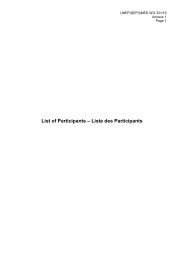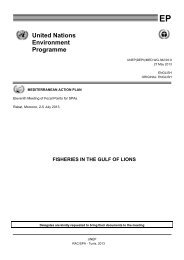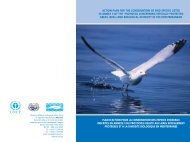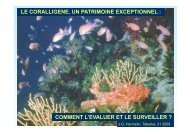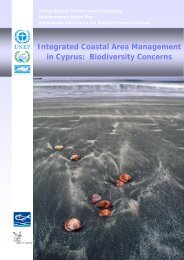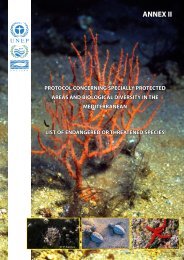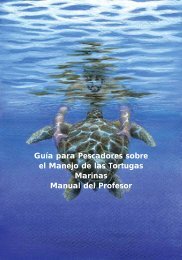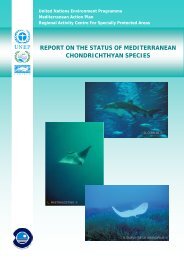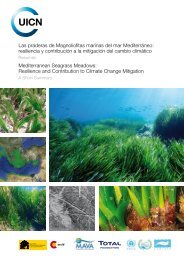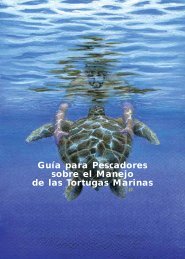Proceedings of the Second Mediterranean Symposium on Marine
Proceedings of the Second Mediterranean Symposium on Marine
Proceedings of the Second Mediterranean Symposium on Marine
Create successful ePaper yourself
Turn your PDF publications into a flip-book with our unique Google optimized e-Paper software.
PROCEEDINGS OF THE SECOND MEDITERRANEAN SYMPOSIUM ON MARINE VEGETATION (ATHENS, 12-13 DECEMBER 2003)<br />
168<br />
MACROALGAL ASSEMBLAGES IN THE GULF OF NAPLES: SPATIAL<br />
VARIABILITY IN RELATION TO ANTHROPOGENIC DISTURBANCE<br />
Ivan GUALA, Ant<strong>on</strong>io ESPOSITO. and Maria Cristina BUIA<br />
Benthic Ecology Laboratory - Stazi<strong>on</strong>e Zoologica ‘A. Dohrn’ Punta S. Pietro 80077 Ischia (Naples) - ITALY<br />
Ivan Guala guala@szn.it<br />
ABSTRACT<br />
Subtidal assemblages are affected by biotic and abiotic factors which work at different<br />
spatial scales; moreover human activities can be an important source <str<strong>on</strong>g>of</str<strong>on</strong>g> variati<strong>on</strong> in<br />
community compositi<strong>on</strong>.<br />
In order to detect <str<strong>on</strong>g>the</str<strong>on</strong>g> macroalgal assemblages variability in relati<strong>on</strong> to anthropogenic<br />
disturbance, a visual assessment <str<strong>on</strong>g>of</str<strong>on</strong>g> <str<strong>on</strong>g>the</str<strong>on</strong>g> cover <str<strong>on</strong>g>of</str<strong>on</strong>g> algal species was performed <strong>on</strong> subhoriz<strong>on</strong>tal<br />
rocky substrates, at both 5 and 10 m depths, in 12 localities <str<strong>on</strong>g>of</str<strong>on</strong>g> <str<strong>on</strong>g>the</str<strong>on</strong>g> Gulf <str<strong>on</strong>g>of</str<strong>on</strong>g><br />
Naples (Italy), for a total <str<strong>on</strong>g>of</str<strong>on</strong>g> 216 observati<strong>on</strong>s.<br />
Important taxa in differentiating localities were identified. Am<strong>on</strong>g <str<strong>on</strong>g>the</str<strong>on</strong>g>se, Caulerpa<br />
racemosa, recently introduced in <str<strong>on</strong>g>the</str<strong>on</strong>g> studied area, was <strong>on</strong>e <str<strong>on</strong>g>of</str<strong>on</strong>g> <str<strong>on</strong>g>the</str<strong>on</strong>g> most important<br />
species in differentiating impacted and relatively undisturbed localities. Deep n<strong>on</strong><br />
impacted communities seem to be more vulnerable to <str<strong>on</strong>g>the</str<strong>on</strong>g> introducti<strong>on</strong> <str<strong>on</strong>g>of</str<strong>on</strong>g> this alien<br />
seaweed. Its invasiveness, strictly linked to its reproductive modality, may be associated<br />
with summer anchorages <str<strong>on</strong>g>of</str<strong>on</strong>g> many leisure boats ra<str<strong>on</strong>g>the</str<strong>on</strong>g>r than with <str<strong>on</strong>g>the</str<strong>on</strong>g> envir<strong>on</strong>mental<br />
c<strong>on</strong>diti<strong>on</strong>s <str<strong>on</strong>g>of</str<strong>on</strong>g> recipient localities.<br />
KEY-WORDS: community diversity, anthropogenic disturbance, rocky substrate,<br />
Caulerpa racemosa.<br />
INTRODUCTION<br />
Urban development and anthropogenic activities are <str<strong>on</strong>g>of</str<strong>on</strong>g>ten <str<strong>on</strong>g>the</str<strong>on</strong>g> cause <str<strong>on</strong>g>of</str<strong>on</strong>g> disturbance <strong>on</strong><br />
marine communities (GESAMP, 1997; Lindegarth and Hoskin, 2001). Plant assemblages<br />
may be threatened by chemical c<strong>on</strong>taminants, excess nutrients, sewage discharge,<br />
reduced light penetrati<strong>on</strong> which can alter species compositi<strong>on</strong> and also limit <str<strong>on</strong>g>the</str<strong>on</strong>g> growth<br />
and depth distributi<strong>on</strong> <str<strong>on</strong>g>of</str<strong>on</strong>g> plant species (Boyle, 1984; GESAMP, 1997; Middelboe and<br />
Sand-Jensen, 1998). Industrial centres, mercantile ports, power plants, touristic and<br />
fishing harbours, aquaculture facilities and, generally, densely populated urban z<strong>on</strong>es,<br />
represent <str<strong>on</strong>g>the</str<strong>on</strong>g> most important sources <str<strong>on</strong>g>of</str<strong>on</strong>g> disturbance.<br />
In recent years many authors have also indicated biological invasi<strong>on</strong>s as a possible threat<br />
to marine envir<strong>on</strong>ment. Trade and transports globalisati<strong>on</strong> has favoured a great increase<br />
<str<strong>on</strong>g>of</str<strong>on</strong>g> marine species introducti<strong>on</strong>s all over <str<strong>on</strong>g>the</str<strong>on</strong>g> world. In suitable c<strong>on</strong>diti<strong>on</strong>s, n<strong>on</strong>-native<br />
species can become invasive, playing a c<strong>on</strong>spicuous role in recipient ecosystems, taking<br />
<str<strong>on</strong>g>the</str<strong>on</strong>g> place <str<strong>on</strong>g>of</str<strong>on</strong>g> native species, affecting <str<strong>on</strong>g>the</str<strong>on</strong>g> biodiversity (Carlt<strong>on</strong> and Geller, 1993;



